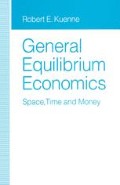Abstract
For a long time the inadequacy of the traditional Weberian agglomeration analysis1 has been fully recognized. Palander, in particular, has pointed up its shortcomings.2 More recently, a fresh and more general approach has been made by P. Sargant Florence and others.3 This approach, primarily an attempt to identify from processed census data meaningful geographical associations in industry, of necessity does not concern itself with the development of a theoretical framework.4
This work was co-authored with Walter Isard and was published originally in the Review of Economics and Statistics, 35 (1953), pp. 289–301. It is reproduced with permission of Elsevier Science Publishers.
The study was done partly under the auspices of the Social Science Research Center, the University of Puerto Rico, and of the Center of Urban and Regional Studies, the Massachusetts Institute of Technology. The basic projections were completed in February 1952 for investment use by the firm of Minot, De Blois and Maddison, who generously financed the work in the initial stage.
Access this chapter
Tax calculation will be finalised at checkout
Purchases are for personal use only
Preview
Unable to display preview. Download preview PDF.
References
American Iron and Steel Institute, Annual Reports, various years.
Barfod, Børge, Local Economic Effects of a Large-Scale Industrial Undertaking, Copenhagen (1958).
Cumberland, J., The Locational Structure of the East Coast Steel Industry with Emphasis on an Integrated New England Steel Mill, PhD Dissertation, Harvard University (1951).
Daly, M. C., ‘An Approximation to a Geographical Multiplier’, Economic Journal, 50 (1940), pp. 248–58.
Engländer, O., ‘Kritisches und Positives zu einer allgemeinen reinen Lehre von Standort’, Zeitschrift für Volkswirtschaft und Sozialpolitik, Neue Folge, 5 (1926).
Evans, W. D., and M. Hoffenberg, ‘The Interindustry Relations Study for 1947’, The Review of Economics and Statistics, 34 (1952) pp 97–142
Federal Reserve Bank of Kansas City, ‘The Employment Multiplier in Wichita’. Monthly Review, 37 (1952).
Florence, P. S. Investment, Location and Size of Plant, Cambridge University Press, Cambridge, UK (1948).
Friedrich, C. J., trans., Alfred Weber’s Theory of Location of Industries, University of Chicago (1929)
Hoover, E. M., Jr., Location Theory and the Shoe and Leather Industries, Harvard University Press, Cambridge, Mass. (1937).
Isard, W., ‘Some Locational Factors in the Iron and Steel Industry Since the Early Nineteenth Century’, Journal of Political Economy, 56 (1948), pp. 203–17.
Isard, W., et al., ‘Input-Output Analysis: Discussion’, Papers and Proceedings of the American Economic Association, 39 (1949), pp. 226–40.
Isard, W., and W. Capron, ‘The Future Locational Pattern of Iron and Steel Production in the United States’, Journal of Political Economy, 57 (1949) pp 118–33
Isard, W., and J. Cumberland, ‘New England as a Possible Location for an Integrated Iron and Steel Works’, Economic Geography, 26 (1950), pp. 245–59.
Isard, W., ‘Interregional and Regional Input-Output Analysis: A Model of a Space-Economy’, Review of Economics and Statistics, 33 (1951), pp. 318–28.
Isard, W., and M. J. Peck, ‘Location Theory and International and Interregional Trade Theory’, Quarterly Journal of Economics, 67 (1953) pp. 97–114.
Isard, W., ‘Some Empirical Results and Problems of Regional Input— Output Analysis’, ch. 5 in W. Leontief, Studies in the Structure of the American Economy, New York (1953).
Joelson, W. K., ‘Suggestions for a Planned Industrial Promotion Program’, Economic Development Administration, San Juan, PR, 1 October 1952.
Johnson, O., Steel Consumption in 1948: A Report by Iron Age to the Metalworking Industry (1949).
Krutilla, J., The Structure of Costs and Regional Advantage in Primary Aluminum Production, PhD dissertation, Harvard University (1952).
Kuenne, Robert. E., The Use of Input-Output Techniques for the Estimation of Employment in the Delaware Valley, PhD dissertation, Harvard University (1953).
Leontief, W., The Structure of American Economy, 1919–1929, Harvard University Press, Cambridge, Mass. (1941).
National Resources Planning Board, Industrial Location and National Resources. US Government Printing Office. Washington, DC (1943).
Niederhauser, E., ‘Die Standortstheorie Alfred Webers’, Staatswirtschaftliche Studien, 14 (1944), pp. 181–7.
Palander, T., Beiträge zur Standortstheorie, Almqvist, Uppsala (1935).
Pennsylvania State Planning Commission, Boom in Bucks County, mimeographed undated
Ullman, E., ‘The Basic-Service Ratio and the Areal Support of Cities’, mimeographed, undated.
US Army, Board of Engineers for Rivers and Harbors, Commercial Statistics: Waterborne Commerce, US Government Printing Office, Washington, DC, various years.
US Army, Board of Engineers for Rivers and Harbors, Annual Reports (1947, 1948) US Government Printing Office, Washington, DC.
US Bureau of the Census, Census of Manufactures, 1947, US Government Printing Office, Washington, DC (1956).
US Bureau of the Census, Census of Business, 1948, US Government Printing Office, Washington, DC (1951).
US Bureau of the Census, Census of Population, 1950, US Government Printing Office Washington, DC (1952–7).
US Bureau of Labor Statistics, Survey of Current Business, July 1949.
US Department of Commerce, Minerals Yearbook, 1947, US Government Printing Office, Washington, DC (1949).
US Department of Labor, Monthly Labor Review, various issues.
US Steel Company, Statement at Public Hearing by US Army Engineers, March 14, 1951, Trenton, NJ, mimeographed.
Author information
Authors and Affiliations
Copyright information
© 1992 Robert E. Kuenne
About this chapter
Cite this chapter
Kuenne, R.E. (1992). The Impact of Steel upon the Greater New York-Philadelphia Industrial Region. In: General Equilibrium Economics. Palgrave Macmillan, London. https://doi.org/10.1007/978-1-349-12752-8_5
Download citation
DOI: https://doi.org/10.1007/978-1-349-12752-8_5
Publisher Name: Palgrave Macmillan, London
Print ISBN: 978-1-349-12754-2
Online ISBN: 978-1-349-12752-8
eBook Packages: Palgrave Economics & Finance CollectionEconomics and Finance (R0)

